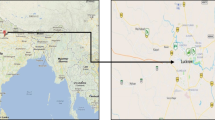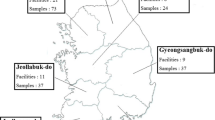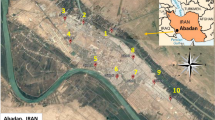Abstract
We measured the concentrations of indoor pollutants (fine particulate matter (PM10)), culturable airborne bacteria (CAB), total volatile organic compounds (TVOCs), formaldehyde (HCHO), CO2, NO2, and O3 in subway stations and public parking lots at a national scale in South Korea in order to determine their possible relationships with other underground environmental factors and facility characteristics. Indoor pollutants were sampled at 59 underground facilities with a total of 187 samples in subway stations and parking lots. Kruskal–Wallis and Mann–Whitney analyses were used to examine the relationships between atmospheric pollutants at underground facilities and indoor/outdoor differences in PM10 and O3 concentrations. Underground PM10 concentrations were higher than outdoor concentrations at all underground facilities (p < 0.001), while underground O3 concentrations were lower than outdoor O3 concentrations at all underground facilities (p < 0.001).

Similar content being viewed by others
References
Alves CA, Calvo AI, Castro A, Fraile R, Evtyugina M, Bate-Epey E (2013) Indoor air quality in two university sports facilities. Aerosol Air Qual Res 13:1723–1730
Assimakopoulos VD, Saraga D, Helmis CG, Stathopoulou OI, Halios CH (2008) An experimental study of the indoor air quality in areas of different use. Glob Nest J 10:192–200
Bateson TF, Schwartz J (2008) Children’s response to air pollutants. J Toxicol Environ Health A 71:238–243
Bozkurt Z et al (2015) Determination of the personal, indoor and outdoor exposure levels of inorganic gaseous pollutants in different microenvironments in an industrial city. Environ Monit Assess 187(590):1–17
Branco PTBS, Nunes RAO, Alvim-Ferraz MCM, Martins FG, Souse SIV (2015) Children’s exposure to indoor air in urban nurseries – part II: gaseous pollutants’ assessment. Environ Res 142:662–670
Chen YY, Sung FC, Chen ML, Mao IF, Lu CY (2016) Indoor air quality in the metro system in North Taiwan. Int J Environ Res Public Health 13:1200
Chithra VS, Shiva Nagendra SM (2014) Seasonal trends of indoor particulate matter concentrations in a naturally ventilated school building. WIT Trans Ecol Environ 183:341–351
Douwes J, Thome P, Pearce N, Heederik D (2003) Bioaerosol health effect and exposure assessment: progress and prospects. Ann Occup Hyg 47(3):187–200
Du Z, Mo J, Zhang Y (2014) Risk assessment of population inhalation exposure to volatile organic compounds and carbonyls in urban China. Environ Int 73:33–45
Elbayoumi M, Ramli NA, Yusof NFFM, Madhoun WA (2013) Spatial and seasonal variation of particulate matter (PM10 and PM2.5) in Middle Eastern classrooms. Atmos Environ 80:389–397
Fahrudin AE, Endarko E, Nasrulloh AV, Sari N (2017) Development of ozone sterilization system based microcontroller for E. Coli bacteria sterilization. J Phys Conf Ser 853:012007
Frankel M, Beko G, Timm M, Gustavsen S, Hansen EW, Madsen AM (2012) Seasonal variations of indoor microbial exposures and their relation to temperature, relative humidity, and air exchange rate. Appl Environ Microbiol 78(23):8289–8297
Gold DR, Allen G, Damokosh A, Serrano P, Hayes C, Castillejos M (1996) Comparison of outdoor and classroom ozone exposures for school children in Mexico city. J Air Waste Manage Assoc 46:335–342
Hromadaka J, Korposh S, Partridge MC, James SW, Davis F, Crump D, Tatam RP (2017) Multi-parameter measurements using optical fibre long period gratings for indoor air quality monitoring. Sensor Actuators B Chem 244:217–225
Hwang SH, Kim IS, Park WM (2017) Concentrations of PM10 and airborne bacteria in daycare centers in Seoul relative to indoor environmental factors and daycare center characteristics. Air Qual Atmos Health 10(2):139–145
Hwang SH, Roh J, Park WM (2018) Evaluation of PM10, CO2, airborne bacteria, TVOCs, and formaldehyde in facilities for susceptible populations in South Korea. Environ Pollut 242:700–708
Kabrein H, Yusof MZM, Leman AM, Afandi A (2017) Improving indoor air quality and thermal comfort in office buildings by using combination filters. IOP Conf Ser: Mater Sci Eng 243:012052
Kim KY, Jeong YI, Kim CN (2007) Distribution of airborne microorganism in the foodstuff manufacture factory. JKSOEH 17(4):335–342
Kim KY, Kim YS, Roh YM, Lee CM, Kim CY (2008) Spatial distribution of particulate matter (PM10 and PM2.5) in Seoul metropolitan subway stations. J Hazard Mater 154(1–3):440–444
Madureira J, Paciencia I, Rufo J, Severo M, Ramos E, Barros H, Fernandes EO (2016) Source apportionment of CO2, PM10 and VOCs levels and health risk assessment in naturally ventilated primary school in Porto, Portugal. Build Environ 96:198–205
Martins V, Moreno T, Minguillon MC, Amato FA, Miguel Ed, Capdevila M, Querol X (2015) Exposure to airborne particulate matter in the subway system. Sci Total Environ 511:711–722
Masih A, Lall AS, Taneja A, Singhvi R (2017) Exposure profiles, seasonal variation and health risk assessment of BTEX in indoor air of homes at different microenvironments of a terai province of northern India. Chemosphere. https://doi.org/10.1016/j.chemosphere.2017.02.105
Mendell MJ, Heath GA (2005) Do indoor pollutants and thermal conditions inschools influence student performance? A critical review of the literature. Indoor Air 15:27–52
Mendes A, Bonassi S, Aguiar L, Pereira C, Neves P, Silva S, Mendes D, Guimaraes L, Moroni R, Teixeira JP (2014) Indoor air quality and thermal comfort in elderly care centers. Urban Climate 14:486–501
Ministry of Environment of Korea (2015) Indoor air quality management in public facilities Indoor Air Quality Management Act Amendment
Moschandreas D, Pagilla KR, Storino LV (2003) Time and space uniformity of indoor bacteria concentrations in Chicago area residences. Aerosol Sci Technol 37:899–906
Pekárek S (2003) Non-thermal plasma ozone generation. Acta Polytech 43(6)
Rogers WJ (2012) Sterilisation techniques for polymers. Sterilisation of Biomaterials and Medical Devices, pp 151–211
Tham KW (2016) Indoor air quality and its effects on humans-a review of challenges and developments in the last 30 years. Energ Buildings 130:637–650
Tsai DH, Lin JS, Chan CC (2012) Office workers' sick building syndrome and indoor carbon dioxide concentrations. J Occup Environ Hyg 9:345–351
USEPA (2016) Available at: http://www.epa.gov/indoor-air-quality-iaq/introduction-indoor-air-quality. Accessed 1 Aug 2018
WHO (World Health Organization) (2000) Air quality guidelines for Europe 2000, vol 91, 2nd edn. WHO Regional Publications, European Series, Copenhagen, p 288
WHO (World Health Organization) (2013) Health effects of particulate matter: policy implications for Countries in Eastern Europe, Caucasus and Central Asia Regional Office for Europe, UN City, Marmorvej 51, DK–2100 Copenhagen
Womack AM, Bohannan BJM, Green JL (2010) Biodiversity and biogeography of the atmosphere. Philos Trans R Soc B 365:3645–3653
Yang J, Nam I, Yun H, Kim J, Oh HJ, Lee D, Jeon SM, Yoo SH, Sohn JR (2015) Characteristics of indoor air quality at urban elementary schools in Seoul, Korea: assessment of effect of surrounding environments. Atmos Pollut Res 6:1113–1112
Funding
This research was supported by the Korea Ministry of Environment (MOE) as the Environmental Health Action Program and the Basic Science Research Program through the National Research Foundation of Korean (NRF) funded by the Ministry of Science, ICT and Future Planning (2018R1C1A1A02037363), and by the Korea government (MSIP) (NRF-2016R1C1B2016366).
Author information
Authors and Affiliations
Corresponding author
Additional information
Publisher’s note
Springer Nature remains neutral with regard to jurisdictional claims in published maps and institutional affiliations.
Rights and permissions
About this article
Cite this article
Hwang, S.H., Park, W.M. Indoor air quality assessment with respect to culturable airborne bacteria, total volatile organic compounds, formaldehyde, PM10, CO2, NO2, and O3 in underground subway stations and parking lots. Air Qual Atmos Health 12, 435–441 (2019). https://doi.org/10.1007/s11869-019-00666-z
Received:
Accepted:
Published:
Issue Date:
DOI: https://doi.org/10.1007/s11869-019-00666-z




